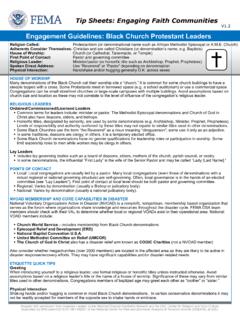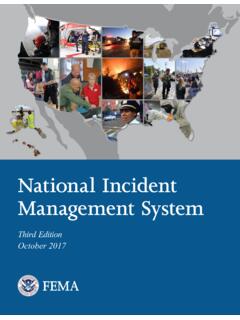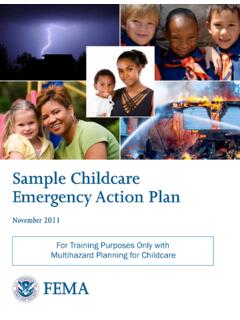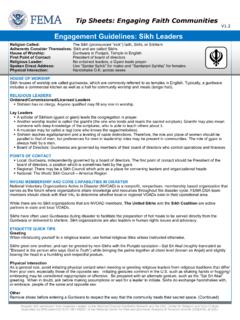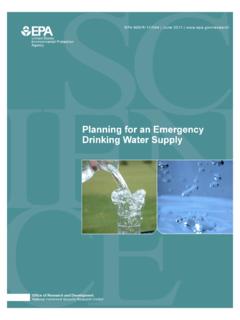Transcription of First Edition September 2011
1 National Preparedness Goal First Edition September 2011 National Preparedness Goal i Table of Contents Introduction .. 1 Core Capabilities .. 2 Overview ..2 Risk and the Core Capabilities ..3 Mission Area: Prevention ..4 Mission Area: Protection ..6 Mission Area: Mitigation ..9 Mission Area: Response ..11 Mission Area: Recovery ..15 Conclusion and Next Steps .. 19 Appendix A: Terms and Definitions .. A-1 National Preparedness Goal ii This page intentionally left blank. National Preparedness Goal 1 Introduction Presidential Policy Directive 8: National Preparedness (PPD-8) describes the Nation s approach to preparing for the threats and hazards that pose the greatest risk to the security of the United States. National preparedness is the shared responsibility of our whole community. Every member contributes, including individuals, communities, the private and nonprofit sectors, faith-based organizations, and Federal, state, and local1 governments.
2 We describe our security and resilience posture through the core capabilities (see Table 1) that are necessary to deal with great risks, and we will use an integrated, layered, and all-of-Nation approach as our foundation. We define success as: A secure and resilient Nation with the capabilities required across the whole community to prevent, protect against, mitigate, respond to, and recover from the threats and hazards that pose the greatest risk. Using the core capabilities, we achieve the National Preparedness Goal by: Preventing, avoiding, or stopping a threatened or an actual act of terrorism. Protecting our citizens, residents, visitors, and assets against the greatest threats and hazards in a manner that allows our interests, aspirations, and way of life to thrive. Mitigating the loss of life and property by lessening the impact of future disasters. Responding quickly to save lives, protect property and the environment, and meet basic human needs in the aftermath of a catastrophic incident.
3 Recovering through a focus on the timely restoration, strengthening, and revitalization of infrastructure, housing, and a sustainable economy, as well as the health, social, cultural, historic, and environmental fabric of communities affected by a catastrophic incident. The core capabilities contained in the Goal are the distinct critical elements necessary for our success. They are highly interdependent and will require us to use existing preparedness networks and activities, improve training and exercise programs, promote innovation, and ensure that the administrative, finance, and logistics systems are in place to support these capabilities. The capability targets2 the performance threshold(s) for each core capability will guide our allocation of resources in support of our national preparedness. Individual and community preparedness is fundamental to our success. By providing the necessary knowledge and skills, we seek to enable the whole community to contribute to and benefit from national preparedness.
4 This includes children, individuals with disabilities and others with access and functional needs, diverse communities, and people with limited English proficiency. Their needs and contributions must be integrated into our efforts. Each community contributes to the Goal and strengthens our national preparedness by preparing for the risks that are most relevant and urgent for them individually. We have made great progress in building and sustaining our national preparedness. The Goal builds on these achievements, but our aspirations must be even higher to match the greatest risks facing our Nation. As we prepare for these challenges, our core capabilities will evolve to meet those challenges. 1 For the purposes of this document, state and local includes tribal and territorial governments. 2 The capability targets will serve as the basis for the development of performance measures to track our progress.
5 National Preparedness Goal 2 Core Capabilities Overview Core capabilities are essential for the execution of each of the five mission areas: Prevention, Protection, Mitigation, Response, and Recovery (see Table 1). To assess both our capacity and our gaps, each core capability includes capability targets for which measures will be developed. The core capabilities and capability targets are not exclusive to any single level of government or organization, but rather require the combined efforts of the whole community. Table 1: Core Capabilities by Mission Area3 Prevention Protection Mitigation Response Recovery Planning Public Information and Warning Operational Coordination Forensics and Attribution Intelligence and Information Sharing Interdiction and Disruption Screening, Search, and Detection Access Control and Identity Verification Cybersecurity Intelligence and Information Sharing Interdiction and Disruption Physical Protective Measures Risk Management for Protection Programs and Activities Screening, Search.
6 And Detection Supply Chain Integrity and Security Community Resilience Long-term Vulnerability Reduction Risk and Disaster Resilience Assessment Threats and Hazard Identification Critical Transportation Environmental Response/Health and Safety Fatality Management Services Infrastructure Systems Mass Care Services Mass Search and Rescue Operations On-scene Security and Protection Operational Communications Public and Private Services and Resources Public Health and Medical Services Situational Assessment Economic Recovery Health and Social Services Housing Infrastructure Systems Natural and Cultural Resources 3 Planning, Public Information and Warning, and Operational Coordination are core capabilities common to all mission areas. National Preparedness Goal 3 These five mission areas serve as an aid in organizing our national preparedness activities, and do not constrain or limit integration across mission areas and core capabilities, which by their nature are highly interdependent and applicable to any threat or hazard.
7 These mission areas exist along a continuum, and there is a dynamic interplay between and among them and even some commonality in the core capabilities essential to each. These core capabilities represent an evolution from the Target Capabilities The transition to core capabilities expands the focus to include Mitigation and allows greater focus on Prevention and Protection activities based on experience since the release of Homeland Security Presidential Directive 8 (HSPD-8). The capability targets associated with these core capabilities are ambitious. These are not targets for any single jurisdiction or agency; achieving these targets will require a national effort involving the whole community. Each mission area relies on the whole community to ensure success. This includes children,5 individuals with disabilities and others with access and functional needs, diverse communities, and people with limited English proficiency.
8 Three core capabilities span all five mission areas: Planning, Public Information and Warning, and Operational Coordination. These common core capabilities serve to unify the mission areas and, in many ways, are necessary for the success of the remaining core capabilities. Additionally, a number of core capabilities directly involve more than one mission area and are listed in each mission area as appropriate. Core capabilities and targets, like the risks we face, are not static. They will be vetted and refined, taking into consideration the risk and resource requirements, during the planning process established through PPD-8. Risk and the Core Capabilities Understanding the greatest risks to the Nation s security and resilience is a critical step in identifying the core capabilities and capability targets. All levels of government and the whole community should present and assess risk in a similar manner to provide a common understanding of the threats and hazards confronting our Nation.
9 The information gathered during a risk assessment also enables a prioritization of preparedness efforts and an ability to identify our capability requirements across the whole community. In accordance with PPD-8, and in coordination with Federal departments and agencies, a Strategic National Risk Assessment was The results of the assessment indicate that a wide range of threats and hazards pose a significant risk to the Nation, affirming the need for an all -hazards, capability-based approach to preparedness planning. Key findings include: Natural hazards, including hurricanes, earthquakes, tornados, wildfires, and floods, present a significant and varied risk across the country. 4 For a crosswalk of the Target Capabilities List against the core capabilities, see 5 Children require a unique set of considerations across the core capabilities and capability targets contained within this document.
10 It is strongly encouraged that this be taken into consideration as part of any integrated planning effort. 6 The complete results of the Strategic National Risk Assessment are classified. For an unclassified summary, see National Preparedness Goal 4 A virulent strain of pandemic influenza could kill hundreds of thousands of Americans, affect millions more, and result in economic loss. Additional human and animal infectious diseases, including those previously undiscovered, may present significant risks. Technological and accidental hazards, such as dam failures or chemical substance spills or releases, have the potential to cause extensive fatalities and severe economic impacts, and the likelihood of occurrence may increase due to aging infrastructure. Terrorist organizations or affiliates may seek to acquire, build, and use weapons of mass destruction (WMD). Conventional terrorist attacks, including those by lone actors employing explosives and armed attacks, present a continued risk to the Nation.



